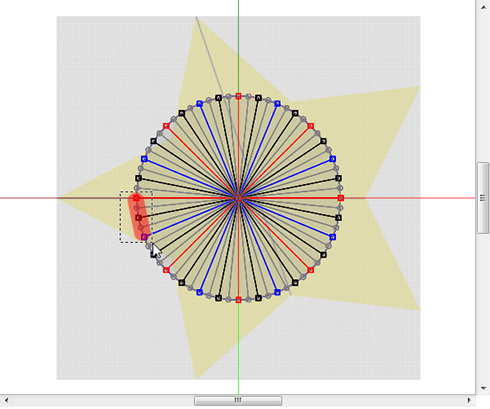Let's make the following star using TATARA 6.0. 
Let's push down the star horizontally and make it.
To make this, I made the following background image.
It is arranged so that it may become symmetrical by the upper and lower sides, when using the mirror function for the transverse direction.
The two black lines are drawn in order to decide the place in which the vertexes gather up and down.
Let's make the star from the following steps.
1) Make the form where the star was seen from the side from ROKURO.
2) Make the stellar form from TSUCHI.
3) Maximize, save and upload to the in-world.
You can check this tutorial by following video.
Let's make the form where the star was seen from the side in ROKURO mode.
The star has the ten vertexes which constitute the stellar form, and the form where those vertexes gathered the front and behind that one. The form seen from the side seems to be the diagram of cards.
Boot TATARA and choose New on the File menu. 
Choose 64x16 of Sphere on the New dialog, and click the OK button. 
The preview pane is displayed as shown in the following figure.
Set Edit Level in the footing of the Edit pane as Near. 
Set Grid on the View menu as 1. 
Click the ROKURO tab and change into ROKURO mode. 
As shown in the following figure, arrange the three control points in piles to one. 
As shown in the lower figure, choose the control points of red area. 
Right-click the edit pane and choose Magnet on the popup menu. The shortcut of the keyboard is Ctrl+B. 
The preview is displayed as shown in the following figure. 
Let's copy the form of the upper half to the bottom half.
Choose Mirror 04-GG from 00-G3 on the Edit menu. 
Click the XY button on the Mirror dialog. 
The edit pane is displayed as shown in the following figure. The upper half was copied to the bottom half. 
Let's edit the form seen from the top in TSUCHI mode.
Click the TSUCHI tab and change into TSUCHI mode. 
As shown in the following figure, click the XY button at the lower left of the edit pane. 
When you click the upper XY button, the upper and lower sides will interchange.
Choose Load Background on the View menu and choose the following background image. 
The edit pane is displayed as shown in the following figure. 
Let's arrange the bottom half, in order to use the mirror function later.
Let's make the control points of the bottom half into the six vertexes.
Please be sure to include the control point of blue or red in the one vertex.
As shown in the following figure, choose the five control points of red area. 
Right-click the edit pane and choose Magnet on the popup menu. The shortcut of the keyboard is Ctrl+B. 
As shown in the following figure, choose the seven control points of red area. 
Right-click the edit pane and choose Magnet on the popup menu. The shortcut of the keyboard is Ctrl+B. 
As shown in the following figure, choose the five control points of red area. 
Right-click the edit pane and choose Magnet on the popup menu. The shortcut of the keyboard is Ctrl+B. 
As shown in the following figure, choose the six control points of red area. 
Right-click the edit pane and choose Magnet on the popup menu. The shortcut of the keyboard is Ctrl+B. 
As shown in the following figure, choose the seven control points of red area. 
Right-click the edit pane and choose Magnet on the popup menu. The shortcut of the keyboard is Ctrl+B. 
As shown in the following figure, choose the four control points of red area. 
Right-click the edit pane and choose Magnet on the popup menu. The shortcut of the keyboard is Ctrl+B. 
As shown in the following figure, choose the five summarized control points by range specification, and arrange on the vertex of star. 
Let's make the stellar form using the mirror function.
Choose Mirror 00-GG from 00-FG on the Edit menu. 
Click the ZX button on the Mirror dialog. 
As shown in the following figure, the bottom half has been arranged in the upper half. 
Adjust the position of the four vertexes in the upper half of the red area of the following figure. 
As shown in the following figure, rearrange the central control point at the intersecting point of the two lines with the black background image. 
The star form was completed. 
Let's upload a sculpt-map file to the in-world.
Let's check Setup before saving.
Choose Setup on the File menu. 
Set TGA Save Size as 64x64 in the displayed dialog.
And let's check the following items.
-Copy Protection by transparent When the prim is modified, you can make it transparent to prevent the texture from being copied by screen capture.
-Auto Maximize The object saved when you save your sculpt map file is maximized automatically. 
If you check Auto Rename, overwrite of a sculpt-map file is prevented.
Let's save your sculpt map file in TGA File form.
Choose Save on the File menu. 
Choose TGA File of Save Dialog and save your file. 
Let's upload a sculpt-map file to the in-world.
When you upload a sculpt-map file, be sure to choose Upload Image.
It costs 10L$ to upload one Sculpt-Map file.
Choose Upload - Image (L$10) on the Build menu. 
Specify “Preview image as” as Sculpted Prim. And check it by the preview. Check Use lossless compression. And click Upload Button.
Build the objelct. And click the Object tab and set Building Block Type to Sculpted on Edit floater. 
Apply your uploaded sculpt map.
Stretch your object suitably. 
The star was completed. 
Original text: http://kanaenet.blogspot.com/2011/10/t619-1.html
This article is automatically translated by the computer interpreter.
Please notify me of any mistakes in translation.



